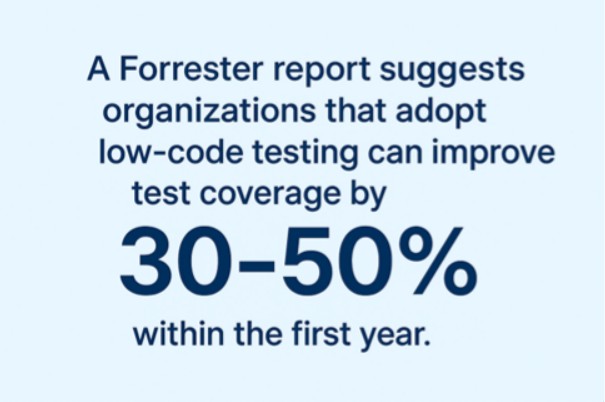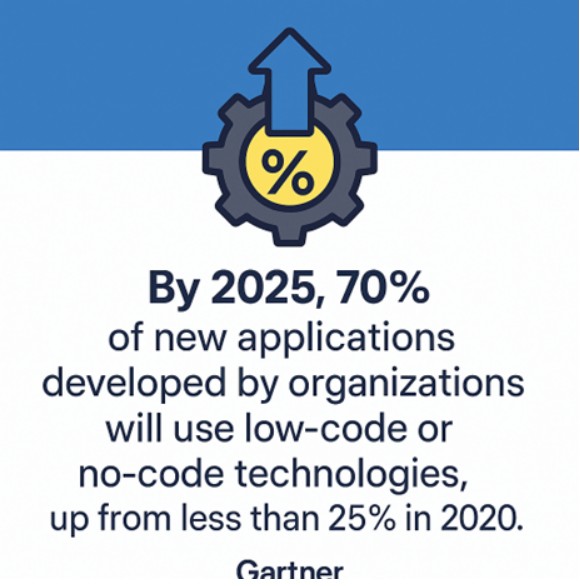
Software Testing is no longer an afterthought—it’s the backbone of reliable, high-quality delivery in today’s digital landscape. With agile and DevOps methodologies pushing organizations to release software faster, test automation has become a critical enabler of continuous delivery and continuous integration.
Yet, even as test automation adoption grows, scaling it across teams and enterprises remains a challenge. Script-heavy frameworks often demand specialized programming skills, test maintenance becomes costly, and QA leaders struggle to involve business stakeholders effectively.
This is where low-code test automation enters the stage. By reducing the dependency on complex coding and making automation more accessible, low-code QA solutions offer a path to faster adoption, broader collaboration, and more scalable automation practices. From multinationals to small and medium businesses, the demand is rising for competent, reliable testing services that leverage low-code automation tools to speed up testing, reduce costs, and unlock greater ROI has never been this high.
The Challenge of Scaling Test Automation
Despite investments in modern test automation platforms, scaling them effectively across large organizations isn’t easy.
Skill Gaps and Bottlenecks
Traditional frameworks like Selenium, Cypress, and Rest Assured require advanced coding expertise. Skilled engineers are limited, creating a bottleneck when QA needs to scale across hundreds or thousands of test cases.
High Maintenance Costs
As applications evolve, automated test scripts break frequently. Research suggests that more than 50% of automation costs are tied to maintenance alone. This makes scaling both costly and inefficient.
Tool Fragmentation
Different teams adopt different tools, leading to silos and duplication of effort. QA leaders struggle to unify test coverage across web, mobile, and API layers.
Limited Onboarding for Non-Technical Testers
Manual testers and business users often find it hard to contribute in a code-centric testing ecosystem. This creates dependency on a few skilled engineers, slowing progress.
Scaling test automation, therefore, isn’t about running more tests—it’s about making testing accessible, maintainable, and collaborative.
For organizations seeking agility and competitive edge, legacy systems have become roadblocks. This is where EDI 2.0 shines.
What Is Low-Code Test Automation?
Low-code test automation refers to platforms that minimize or eliminate the need for coding in creating and executing automated tests.
- They use drag-and-drop interfaces, record-and-playback features, and AI-driven flows to simplify test creation.
- Non-programmers (like manual testers or business analysts) can design and execute tests, contributing directly to QA coverage.
- For engineers, most platforms offer a hybrid model where you can extend low-code flows with scripting for complex logic.
This combination of simplicity and flexibility makes low-code QA solutions ideal for scaling automation across diverse teams.
Benefits of Low-Code for Scaling QA
Low-code automation tools are reshaping how enterprises approach scaling test automation. Here’s why:
Speed
Automated tests can be accelerated with low-code testing as compared to script-heavy frameworks. QA teams no longer need to spend weeks building regression suites from scratch.
Collaboration
Manual testers, business analysts, and even product owners can review or design test cases. This democratizes automation and ensures closer alignment with business needs.
Reduced Maintenance
Modern AI-powered test automation platforms include self-healing capabilities. They can detect changes in user interface components and update the affected scripts automatically. This ability to repair – or self-heal – scripts without human intervention helps bring down the requirement of manual updates drastically.
Scalability
Cross-browser, mobile, API, and microservices testing can be scaled across environments with minimal setup. This enables end-to-end test coverage without specialized infra management.
Lower Skill Barrier
By lowering the coding requirement, low-code QA solutions open doors for “citizen automators” or non-technical staff who can contribute to test creation.
A Forrester report suggests organizations that adopt low-code testing can improve test coverage by 30–50% within the first year.

Another report by Gartner suggests that by 2025, 70% of new applications developed by organizations will use low-code or no-code technologies, up from less than 25% in 2020.

Popular Low-Code Test Automation Tools (2025)
The low-code automation tools market has matured significantly. As of 2025, several platforms stand out for QA leaders:
- Katalon Studio: A hybrid model combining record-and-playback with scripting for flexibility.
- Tricentis Tosca: Enterprise-grade, designed for large-scale, end-to-end software testing.
- ACCELQ: AI-powered, fully codeless automation with integrations for API, UI, and mobile.
- Testim.io: Uses AI for test creation, with self-healing features.
- Mabl: Cloud-native test automation platform with self-healing and CI/CD integrations.
These platforms are not just tools; they represent a shift toward scalable, AI-powered test automation ecosystems.
Use Cases for Scaling with Low-Code
1. Web & Mobile Apps
Functional, regression, and UI testing can be accelerated using low-code QA solutions, reducing reliance on specialized developers.
2. API Testing
Low-code platforms allow recording API flows and auto-generating assertions, making low-code testing valuable in microservices-heavy architectures.
3. End-to-End Testing
Distributed microservices and hybrid cloud systems require test automation platforms that handle complexity seamlessly.
4. CI/CD Integration
With DevOps pipelines, AI-powered test automation ensures continuous testing at every commit, reducing release risks.
Limitations of Low-Code
While promising, low-code automation tools come with challenges:
- Vendor Lock-in: Switching platforms can be costly.
- Complex Logic Gaps: Edge cases may still require coding.
- Cost: Enterprise-grade test automation platforms can be expensive.
- Skill Needs: Teams still need coding knowledge for custom scripts.
CXOs must weigh these risks before adopting at scale.
Best Practices for Scaling Automation with Low-Code
1. Hybrid Strategy → Combine low-code with scripting to balance speed and flexibility.
2. CI/CD Integration → Ensure your low-code test automation tool works seamlessly with Jenkins, GitHub Actions, or Azure DevOps.
3. Train Citizen Automators → Upskill manual testers into low-code contributors.
4. Start Small, Scale Gradually → Begin with smoke/regression, then expand to end-to-end coverage.
Look for partners that specialize in implementing hybrid automation strategies, ensuring enterprises leverage the right balance of speed and flexibility. Having the right testing services partner can help QA leaders achieve scalable automation.
Conclusion
Low-code test automation is not about replacing engineers—it’s about scaling test automation faster, smarter, and more collaboratively. By lowering the skill barrier and leveraging AI-powered test automation, enterprises can unlock faster coverage, improved ROI, and enhanced business alignment.
The future points to autonomous testing ecosystems, where low-code QA solutions integrate AI, predictive analytics, and self-healing at scale.
For CXOs, the message is clear: adopt low-code automation tools not just to keep pace, but to stay ahead in quality and speed. Ready to scale your QA efforts? Explore ESSPL’s Testing Services today and see how low-code testing can redefine your automation strategy.


